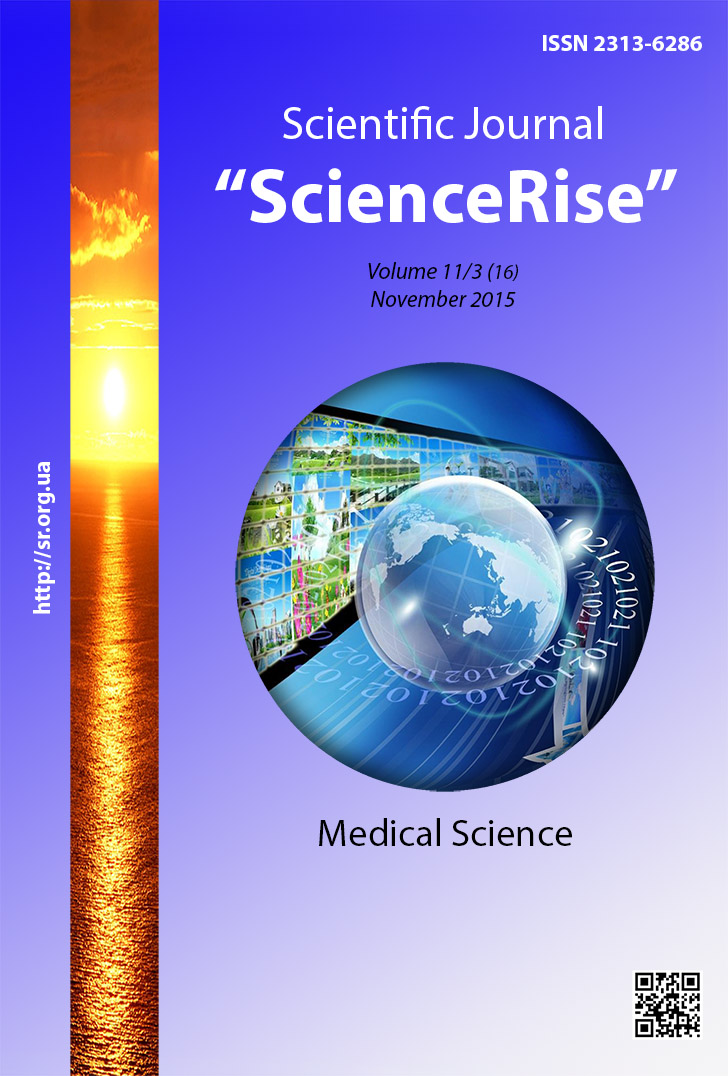Prevalence of TLR-4 gene polymorphism in patients co-infected with HIV/HCV
DOI:
https://doi.org/10.15587/2313-8416.2015.54495Keywords:
HIV|HCV co-infection, Toll-like receptors, metabolic disorders, cytokines, lipid metabolism, insulin-resistanceAbstract
There was studied the prevalence of Asp299Gly polymorphism of TLR-4 gene in patients co-infected with HIV-HCV.
Methods. To define the frequency of Asp299Gly polymorphism of TLR-4 gene there were examined 47 patients co-infected with HIV\HCV and 30 healthy donors by the method of polymorphism of the long restrictive fragments (PLRF) – polymerase chain reaction (PCR). Among examined persons there were 21 (44,7 %) women, 26 (55,3 %) – men. The mean age was 36,2±2,4 years, from 21 to52 years old.
Results. The correlative analysis indicates the reverse dependency between Asp299Gly polymorphism of TLR-4 gene and Zn content (r=-0,34; p<0,05), relative numder of CD4+,% (r=-0,32; p<0,05) in blood serum of patients co-infected with HIV\HCV. At the same time in patients co-infected with HIV\HCV there was noticed the direct dependency between Asp299Gly polymorphism of TLR-4 gene and α tumor necrosis factor (r=0,32; p<0,05), С-reactive protein (r=0,34; p<0,05), absolute number of СD3+ Т-lymphocytes (r=0,34; p<0,05), TG level (r=0,39; p<0,02), absolute numder of CD45+ Т-lymphocyte (r=0,45; p<0,001), insulin level (r=0,66; p<0,001) and insulin-resistance (r=0,66; p<0,001).
Conclusions: In patients co-infected with HIV\HCV the Asp299Gly polymorphism of TLR-4 gene is reliably more often than the control group (χ2=4,5; р<0,05). The correlative analysis demonstrated the powerful direct dependency between Asp299Gly polymorphism of TLR-4 gene and clinical stage of disease in patients co-infected with HIV\HCV (r=0,43; p<0,001)
References
Kozko, V. N., Iurko, K. V., Krasnov, M. I. (2010). Characteristics of the HIV epidemic in Ukraine. Provіzor, 23, 7–12.
Maksimov, S. L. (2010). The clinical course, outcomes and treatment of viral hepatitis in patients with HIV infection. Moscow, 46.
Fedorchenko, S. V. (2010). Chronic HCV-infection. Kyiv: TNI "Medicine", 271.
Jialal, I., Huet, B. A., Kaur, H., Chien, A., Devaraj, S. (2012). Increased Toll-Like Receptor Activity in Patients With Metabolic Syndrome. Diabetes Care, 35 (4), 900–904. doi: 10.2337/dc11-2375
Takeda, K. (2004). Toll-like receptors in innate immunity. International Immunology, 17 (1), 1–14. doi: 10.1093/intimm/dxh186
Schwartz, B., Colberg, B. (2010). Physiological and pathological role of the receptors of the innate immune system of fatty tissue. Patologicheskaya physiology and experimental medicine, 3, 45–51.
Crane, M., Visvanathan, K., Lewin, S. R. (2012). HIV Infection and TLR Signalling in the Liver. Gastroenterology Research and Practice, 2012, 1–8. doi: 10.1155/2012/473925
8. Kyrychenko, T. C. (2014). Clinical and epidemiological characteristic of HIV-infection and the treatment effectiveness estimation based on role detection of Asp299Gly TLR-4 gene polymorphism. Vinnica, 20.
Lorenz, E., Frees, K. L., Schwartz, D. A. (2001). Determination of the TLR4 genotype using allele-specific PCR. Biotechniques, 31 (1), 22–24.
Zosimov, A. N. (2000). System analysis in medicine. Kharkov: Tornado, 82.
Downloads
Published
Issue
Section
License
Copyright (c) 2015 Катерина Володимирівна Юрко

This work is licensed under a Creative Commons Attribution 4.0 International License.
Our journal abides by the Creative Commons CC BY copyright rights and permissions for open access journals.
Authors, who are published in this journal, agree to the following conditions:
1. The authors reserve the right to authorship of the work and pass the first publication right of this work to the journal under the terms of a Creative Commons CC BY, which allows others to freely distribute the published research with the obligatory reference to the authors of the original work and the first publication of the work in this journal.
2. The authors have the right to conclude separate supplement agreements that relate to non-exclusive work distribution in the form in which it has been published by the journal (for example, to upload the work to the online storage of the journal or publish it as part of a monograph), provided that the reference to the first publication of the work in this journal is included.

